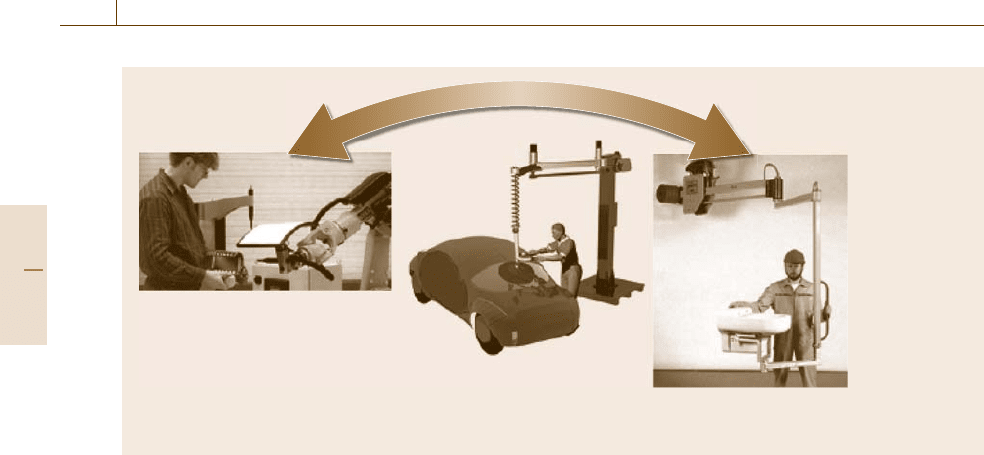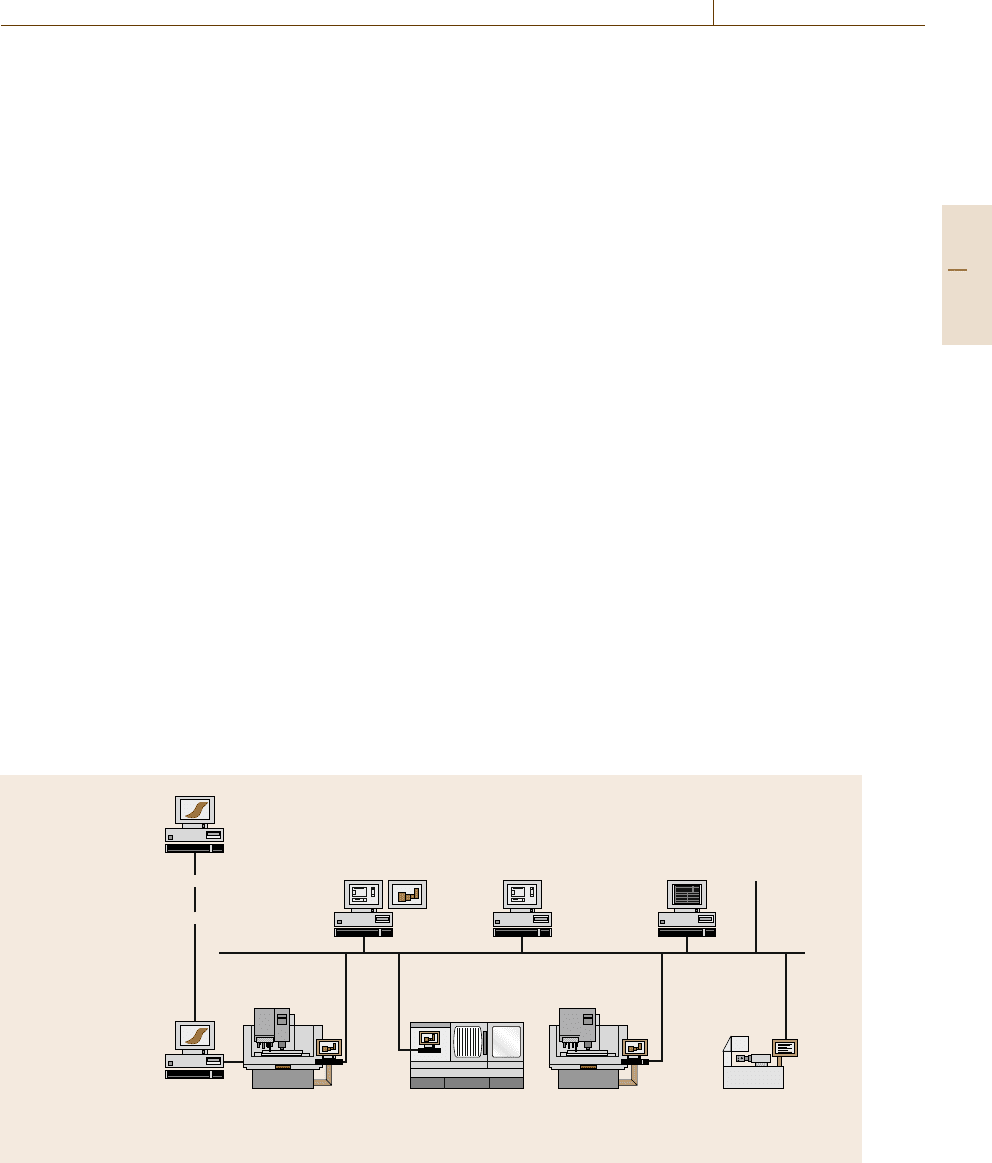Nof S.Y. Springer Handbook of Automation
Подождите немного. Документ загружается.


715
Quality of Ser
41. Quality of Service (QoS) of Automation
Heinz-Hermann Erbe (Δ)
Quality of service (QoS) of automation involves
issues of cost, affordability, energy, mainte-
nance, and dependability. This chapter focuses
on cost, affordability, and energy. (The next chap-
ter addresses the other aspects.) Cost-effective
or cost-oriented automation is part of a strat-
egy called low-cost automation. It considers the
lifecycleofanautomationsystemwithrespect
to their owners: design, production, operating,
and maintenance, refitting or recycling. Afford-
able automation is another part of the strategy.
It considers automation or automatic control in
small enterprises to enhance their competitiveness
in manufacturing and service. Despite relative ex-
pensive components the automation system can
be cheap with respect to operation and main-
tenance. As examples are discussed: numerical
controls of machine tools; shop floor control with
distributed information processing; programmable
logic controllers (PLCs) shifting to general-purpose
(PC); smart devices, i. e. information processing in-
tegrated in sensors and actuators; and distributed
manufacturing, and maintenance.
Energy saving can be supported by auto-
matic control of consumption in households, office
buildings, plants, and transport. Energy intensity
is decreasing in most developing countries, caused
by changing habits of people and by new control
strategies. Centralized generation of electrical en-
ergy has advantages in terms of economies of scale,
but also wastes energy. Decentralized generation
41.1 Cost-Oriented Automation..................... 718
41.1.1 Cost of Ownership ........................ 718
41.1.2 Robotics...................................... 719
41.2 Affordable Automation ......................... 721
41.2.1 Smart Devices .............................. 721
41.2.2 Programmable Logic Controllers
as Components
for Affordable Automation............. 722
41.2.3 Production Technology.................. 723
41.3 Energy-Saving Automation.................... 725
41.3.1 Energy Generation ....................... 725
41.3.2 Residential Sector ........................ 726
41.3.3 Commercial Building Sector ........... 726
41.3.4 Transportation Sector.................... 727
41.3.5 Industrial Sector........................... 727
41.4 Emerging Trends .................................. 728
41.4.1 Distributed Collaborative
Engineering................................. 728
41.4.2 e-Maintenance and e-Service ....... 730
41.5 Conclusions .......................................... 731
References .................................................. 732
of electricity and heat in regional or local units are
of advantage. A combination of wind energy, solar
energy, hydropower, energy from biomass, and
fossil fuel in small units could provide electrical
energy and heat in regions isolated from grids.
These hybrid energy concepts are demanding
advanced, but low-cost, controls.
The term low-cost automation was born in 1986 at
a symposium in Valencia sponsored by the International
Federation of Automatic Control [41.1]. However, the
use of this term led to a misunderstanding of low-cost
automation as a technology with poor performance,
although the intention was to promote affordable au-
tomation devices and to reduce the life cycle cost
or cost of ownership of automation systems. The in-
tention was also to bridge the gap between control
theory and control engineering practice by applications
using low-cost techniques. Ortega [41.2] pointed out
that the transfer of knowledge between the academic
Part E 41

716 Part E Automation Management
community and the industrial user is far from satis-
factory, and it still is, particular regarding small- and
medium-sized industry. However, developments in con-
trol theory are based on principles that can appeal to
concepts with which the practical engineer is famil-
iar. Despite the successfully demonstration of advances
of modern control methods over classical ones, actual
implementations of automatic control in manufacturing
plants show a preference for classical proportional–
integral–derivative (PID) control. Two key factors are
considered [41.3]:
1. Return on investment (better, cheaper, and faster)
2. Ease of application.
To be utilized broadly, a new technology must
demonstrate tangible benefits, be easier to implement
and maintain,and/or substantiallyimprove performance
and efficiency. Sometimes a new control method is
not pursued due to poor usability during operation
and troubleshooting in an industrial environment. The
PID, due to its simplicity, whether implemented ana-
log or digital, provides advantages in its application.
However, manufacturing systems are becoming more
complex. Control needs include single-input/single-
output SISO and multiple-input/multiple-output MIMO
controllers. Therefore control techniques beyond PID
control become necessary. State-space methods are well
developed and provide many advantages if well under-
stood [41.3].
Low-cost automation is now established as a strat-
egy to achieve the same performance as sophisticated
automation but with lower costs. The designers of au-
tomation systems have a cost frame within which they
have to find solutions. This is a challenge to theory and
technology of automaticcontrol, asthe main parts of au-
tomation. Low-cost automation isnot anoxymoron, like
military intelligence or jumbo shrimps. It opposes the
rising cost of sophisticated automation and propagates
the use of innovative and intelligent solutions at afford-
able cost. The concept can be regarded as a collection of
methodologies aiming at the exploitation of tolerance
to imprecision or uncertainties to achieve tractability,
robustness, and finally low-cost solutions. Mathemati-
cally elegant designs of automation systems are often
not feasible because of their neglect of real-world prob-
lems, and in addition are often very expensive for their
owners.
Cost aspects are mostly considered when designing
automation systems. However, in the end, industry is
looking for intelligent solutions and engineering strate-
gies for saving cost but that nevertheless have secure,
high performance. Field robots in several domains such
as manufacturing plants, buildings, offices, agricul-
ture, and mining are candidates for reducing operation
cost. Enterprise integration and support for networked
enterprises are considered as cost-saving strategies.
Human–machine collaboration is a new technological
challenge, and promises more than cooperation. Last
but not least, condition monitoring of machines to re-
duce maintenancecost andavoid downtime of machines
and equipment, if possible, is also a new challenge, and
promotes e-Maintenance [41.4] and e-Service [41.5].
The reliability of low-cost automation is indepen-
dent of the grade of automation, i.e., it covers all
possible circumstances in its field of application. Often
it is more suitable to reduce the grade of automa-
tion and involve human experience and capabilities to
bridge the gap between theoretical findings and practi-
cal requirements [41.6]. On the other hand, theoretical
findings in control theory and practice foster intelli-
gent solutions with respect to saving costs. Anyway,
reliability is a must for all automation systems, al-
though this requirement has no one-to-one relation to
cost.
As an example one may consider computer-
integrated manufacturing (CIM). The original concept
of CIM connected automatically the design of parts
to machines at the workshop via shop floor planning
and scheduling software, and therefore used a lot of
costly components and instruments. After a while this
kind of automation turned out not to be cost effec-
tive, because the centralized control system had to fight
against uncertainties and unexpected events. Decen-
tralization of control and the involvement of human
experience and knowledge along the added-value chain
of the production process required less sophisticated
hardware and software and reduced manufacturing cost,
which allowed CIM to break through even in small and
medium-sized enterprises [41.7].
Low-cost automation also concerns the implemen-
tation of automation systems. This should be as easy
as possible and also facilitate maintenance. Mainte-
nance is very often the crucial point and an important
cost factor to be considered. Standardization of compo-
nents of automation systems could also be very helpful
to reduce cost, because it fosters usability, distribu-
tion, and innovation in new applications, for example
fieldbus technology in manufacturing and building
automation.
The components of an automation/control system,
such as sensors, actuators and the controller itself, can
incorporate advances in information technology. Lo-
Part E 41

Quality of Service (QoS)ofAutomation 717
cal information processing allows for integration at the
level of components, reducing total cost and provid-
ing new features in control lines. They may be wireless
connected because of low data stream rates. Smart
sensors and actuators are new developments for indus-
trial automation [41.8]. The cost of wireless links will
fall while the cost of wired connections will remain
about constant, making wireless increasingly a logi-
cal choice for communication links. However, wireless
links will not be applicable in all situations, notably
those cases where high reliability and low latencies are
required. The implication for factory automation sys-
tems is that processing and storage will become cheap:
every sensor, actuator, and network node can be eco-
nomically provided with unlimited processing power.
If processing and storage systems become inexpen-
sive relative to wiring costs, then the trend will be to
locate processing power near where it is needed in or-
der to reduce wiring costs. The trend will be to apply
more processing and storage systems when and where
they will reduce the cost of interconnections. The cost
of radio and networking technology has fallen to the
point where a wireless connection is already less ex-
pensive than many wired connections. New technology
promises to further reduce the cost of wireless connec-
tions [41.9].
Distributed collaborative engineering, i.e., the con-
trol of common work over remote sites, is now an
emerging topic in cost-oriented automation. Integrated
product and process development as a cost-saving strat-
egy has been partly introduced in industry. However, as
Nnaji et al. [41.10] mention, lack of information from
suppliers and working partners, incompleteness and in-
consistency of product information/knowledge within
the collaborating group, and incapability of processing
information/data from other parties due to the problem
of interoperability hamper effective use. Hence, collab-
orative design tools are needed to improve collaboration
among distributed design groups, enhance knowledge
sharing, and assist in better decision making. (See also
Chaps. 26, 88.)
Mixed-reality concepts could be useful for col-
laborative distributed work because they address two
major issues: seamlessness and enhancing reality.
In mixed-reality distributed environments information
flow can cross the border between reality and virtual-
ity in an arbitrary bidirectional way. Reality may be
the continuation of virtuality, or vice versa [41.11],
which provides a seamless connection between the
two worlds. This bridging or mixing of reality and
virtuality opens up some new perspectives not only
for work environments but also for learning or train-
ing environments [41.12, 13]. (See also Chaps. 15,
86.)
The changing global context is having an impact on
local and regional economies, particularly on small and
medium-sized enterprises. Global integration and inter-
national competitive pressures are intensifying at a time
when some of the traditional competitive advantages –
such as relatively low labor costs – enjoyed by certain
countries are vanishing.
One can see growing emphasis on strategies for
encouraging supply-chain (vertical) and horizontal net-
working. These could be means for facilitating agile
manufacturing. Agile manufacturing is built around the
synthesis of a number of independent enterprises form-
ing a network to join their core skills, competencies,
and capacities to be able to operate profitably in a com-
petitive environmentcharacterized by unpredictable and
continually changing customer demands. Agile manu-
facturing is underpinned by collaborative design and
manufacturing in networks of legally separate and spa-
tially distributed companies. Such networks are useful
in optimizing current processes and mastering sporadic
change in demand, material, and technology [41.14].
Distributed collaborative automation in manufacturing
networks is therefore an emerging area for automatic
control.
Energy-saving strategies and also individual solu-
tions for reducing energy consumption are challenging
politicians, the public, and researchers. The cost aspect
is very important. Components of controllers such as
sensors and actuators may be expensive, but one has to
calculate savings in energy costs over a certain period
or life cycle of a building or plant.
Energy provision and consumption based on finite
resources can cause conflicts between customers, and
between customers and suppliers. Energy savings are
necessary due to these finite resources. Effective use of
available energy can be supported by automatic control
of consumption in households, office buildings, plants,
and transportation. Energy intensity is decreasing in
most developing countries. This is caused by changing
habits of people but also by new control strategies. The
use of energy in a country, in the residential sector, the
commercial building sector, the transportation sector,
and the industrial sector, influences the competitiveness
of the economy, the environment, and the comfort of the
inhabitants.
Building automation is generally a highly cost-
oriented business. The goal is to provide acceptable
comfort conditions at the lowest possible cost in terms
Part E 41

718 Part E Automation Management
of implementation, operation, and maintenance. Energy
saving is one of the most important goals in building
automation [41.15]. (See also Chap.62.)
In Sect.41.1 the strategy of cost-oriented automa-
tion will be explained with the examples of cost of
ownership and robotics. Section 41.2 continues, cov-
ering affordable automation with subsections on smart
devices, i.e., information processing embedded in sen-
sors, and actuators, programmable logic controllers
as important components of an affordable automa-
tion, and examples of low-cost production technology.
Section 41.3 covers energy saving with automatic con-
trol using the aforementioned strategies. (See also
Chap.40.)
41.1 Cost-Oriented Automation
Cost-oriented automation as part of the strategy of low-
cost automation considers the cost of ownership with
respect to the life cycle of the system:
•
Designing
•
Implementing
•
Operating
•
Reconfiguring
•
Maintenance
•
Recycling.
Components and instruments could be expensive if life
cycle costs are to decrease. An example is enterprise
integration or networked enterprises as production sys-
tems that are vertically (supply chain) or horizontally
and vertically (network) organized.
Cost-effective product and process realization has
to consider several aspects regarding automatic con-
trol [41.13]:
•
Virtual manufacturing supporting integrated prod-
uct and process development
•
Tele- or web-based maintenance (cost reduction
with e-Maintenance systems in manufacturing)
•
Small and medium-sized (SME)-oriented agile
manufacturing.
Agile manufacturing here is understood as the synthesis
of a number of independent enterprises forming a net-
work to join their core skills.
As mentioned above, life cycle management of
automation systems is important regarding cost of
ownership. The complete production process has to
be considered with respect to its performance, where
maintenance is the most important driver of cost. Nof
et al. [41.16] consider the performance of the complete
automation system, which interests the owner in terms
of cost, rather than only the performance of the control
system; i. e., a compromise between cost of mainte-
nance and cost of downtime of the automation system
has to be found.
41.1.1 Cost of Ownership
A large amount of the cost of a manufacturing plant
over its lifetime is spent on implementation, ramp up,
maintenance, and reconfiguration. Cost-of-ownership
analysis makes life cycle costs transparent regard-
ing purchase of equipment, implementation, operation
costs, energy consumption, maintenance, and recon-
figuration. It can be used to support acquisition and
planning decisions for a wide range of assets that have
significant maintenance or operating costs throughout
their usable life. Cost of ownership is used to support
decisions involving computing systems, vehicles, lab-
oratory and test equipment, manufacturing equipment,
etc.
It brings out the hidden or nonobvious ownership
costs thatmight otherwisebe overlooked in making pur-
chase decisions or planning budgets. The analysis is not
a complete cost–benefit analysis. It pays no attention to
benefits otherthan cost savings when different scenarios
are compared. When this approach is used in decision
support, it is assumed that the benefits from all alterna-
tives are more or less equal, and that choices differ only
on the cost side.
In highly industrialized countries the type and
amount of automation mostly depends on the cost of
labor. However, automation in general is not always
effective [41.17]. A recent study carried out by the
Fraunhofer Institute of Innovation and System Tech-
nology regarding the grade of automation within the
German industry [41.6] found that companies are re-
fraining from implementing highly automated systems.
The costs of maintenance and reconfiguration are con-
sidered too high; it would be more cost effective to
involve well-qualified operators. The same considera-
tions were discussed by Blasi and Puig [41.18]:
Automation is not useful by itself: there are a lot
of additional requirements to accomplish its func-
Part E 41.1

Quality of Service (QoS)ofAutomation 41.1 Cost-Oriented Automation 719
tion as needed, not only putting automation into the
factories, putting automation just where it is needed
and economically justified.
Blasi and Puig [41.18] consider the challengesof manu-
facturing processes of consumer goods. They stress that
automation helps in providing homogeneous operation,
but for many operations humans can sometimes carry
out the task better than automation systems. However,
humans are failure prone, emotionally driven, and do
not constantly operate at the same level, which also has
to be considered.
Morel et al. [41.19], as mentioned in the Introduc-
tion, stress the consideration of the whole performance
of a plant, rather than the control performance only,
which is what interests the owner regarding cost; i. e.,
a compromise between cost of maintenance and cost of
downtime of the automation systems in a plant regard-
ing commitments to customers or market must be con-
sidered. Scheduled maintenance can be shifted, but it is
of course better to implement condition-based mainte-
nance, in which degradation of parts can be observed
and the decision to run a machine or piece of equipment
for a certain extra time to fulfill a relevant customer
order can be made reasonably based on collected data.
Blasi and Puig [41.18] consider the conditions for
successful automation in industrial applications. Based
on their experiences, a manufacturing engineer dealing
with plant automation should bear in mind that proper
automation is much more than a matter of machines and
equipment. The organization of work in the whole plant
involving the human experience at all stages and always
considering possible improvements with automation or
not is the challenge for engineers and management
to save costs. Automation helps in providing homo-
geneous manufacturing processes. In many operations,
humans can sometimes carry out the task better without
automation. Humans may perform better than any auto-
matic machine, for the time being, but it is impossible
for them to assure constant quality. Where reasonable
cost is critical, inspecting the image quality of a screen,
for example, is a task reserved, for the moment, to hu-
mans, because computer vision is too expensive.
To summarize this section Fig.41.1 shows the main
cost contributions which are of interest to the owner of
the machine and manufacturing equipment.
41.1.2 Robotics
Robots were created in order to automate, optimize,
and ameliorate work processes that had up to then been
Design Stage
Lifecycle of
machine
and
equipment
Engineering design cost
Drawing cost
Computer processing cost
Design modification cost
Management cost
Production preparation cost
Implementation cost
Material cost
Facility cost
Production cost
Maintenance cost
Retrieval cost
Reconfiguration cost
Disassembly cost
Recycling cost
Ramp-up
stage
Disposal and
recycling stage
Manufacturing
stage
Fig. 41.1 Cost contributions of the life cycle of machine and equip-
ment
carried out by humans alone. For reasons of safety, hu-
mans may not enter the working space of the robot.
Recently it has been shown, however, that robots can-
not come close to matching the abilities or intelligence
of humans. Therefore, new systems which enable col-
laboration between humans and robots are becoming
increasingly important. The advantages of using inno-
vative robots can especially be seen in medical or other
service-oriented areas as well as in the emerging area of
humanoid robots.
Although robot technology is mostly regarded as
costly, one can see today applications not only in
customized mass production (automobile industry) but
also in small and medium-sized enterprises (SMEs),
manufacturing small lots of complex parts. Increasing
product variety and customer pressure for short deliv-
ery times put robots in the focus. Robots can be used
for loading and unloading of machine tools or other
equipment such as casting machines, injection mold-
ing machines, etc. Here mostly the robots are stationary,
and their control is coordinated with the control of the
machine or equipment they serve.
Evenfield robotsare applicablewith affordable cost.
Ollero et al. [41.20] describe as an example (among
other applications) an autonomous truck, which could
also be an unmanned vehicle in a manufacturing site.
Low cost should be referred to the components to be
used as well as to system design and maintenance.
Sometimes a trade-off between general-purpose com-
ponents and components tailored to the application has
Part E 41.1

720 Part E Automation Management
Intelligent power assisting device
Realistic approach for complex
assembly and handling processes
in industry and service branche
Passive
handling
manipulator
Safety
Low costs
Simple operation
Industrial robot
Precision
Path control
Sensor-based control
P
r
o
g
r
a
m
m
i
n
g
G
u
i
d
a
n
c
e
Fig. 41.2 Cobots, a new class of handling devices, which combine the characteristics of robots and hand-guided manip-
ulators [41.24]
to be considered. Given the high cost of components,
the design of the field robot should consider modularity,
and simple assembly, reliability maintenance, and fault-
detection properties are important for reducing cost in
terms of the life cycle. Sasiadek and Wang [41.21]
report on low-cost positioning of autonomous robots
fusing, data sensed by global positioning system (GPS)
and inertial navigation system (INS). Automation in
deep mining with autonomous guided vehicles (AGV)
saves cost in terms of healthcare of workers, provision
of energy (using fuel cells),and compressedair required
to maintain working conditions. For navigation, GPS is
not available for this application, therefore radio bea-
cons together with INS can be used. The vehicles and
their control are discussed by Dragt et al. [41.22]and
Sasiadek and Lu [41.23].
Wang et al. [41.25] developed a low-cost robot plat-
form for control education.
Applications of robots in automated assembly and
disassembly fail mostly because the environment can-
not be sufficiently structured. This was the reason for
the development of collaborative robots (cobots) or in-
telligent (power) assisting devices (I(P)AD) (Fig.41.2).
It was also motivated by ergonomic problems in as-
sembly of parts, where parts weight endangered the
human body. Cobots offer a cost-effective solution for
material handling. Complete automation of assembly
processes is complicated, if not impossible. Reconfig-
uration of robots performing assembly tasks could be
very costly. Humans, on the other hand, have capabili-
ties that are difficult to automate, such as parts-picking
from unstructured environments, identifying defective
parts, fitting parts together despite minor shape varia-
tions, etc. Cobots are passive systems which are set in
motion and guided by humans. The cobot concept sup-
poses that shared control, rather than amplification of
human power, is the key enabler [41.26]. The main task
of the cobot is to convert a virtual environment, defined
in software, into physical effect on the motion of a real
payload, and thus also on the motion of the worker.
Overhead gantry-style rail systems used in many shops
can beconsidered cobots but without the virtual surface.
Virtual surfaces separate the region where the worker
can freely move the payload from the region that cannot
be penetrated. These surfaces or walls have an effect on
the payload like a ruler guiding a pencil. Technically
cobots are based on continuously variable transmis-
sions (CVT). Peshkin et al. [41.26] developed spherical
CVTs, and Surdilovic et al. [41.24] developed CVTs
based on a differential transmission.
Part E 41.1

Quality of Service (QoS)ofAutomation 41.2 Affordable Automation 721
41.2 Affordable Automation
This strategy of low-cost automation focuses on mak-
ing systems affordable for their owners with respect to
the problem to be solved. An example is a manufactur-
ing systemin asmall ormedium-sized enterprise,where
automation increases productivity and therefore com-
petitiveness. Although small enterprises agree that at
least routine work can be done better when automated,
there is still a fear that automation will be sophisti-
cated, failure prone, need experts for maintenance and
reconfiguration, and therefore would be costly.
Soloman [41.27] points to shortening product life
cycles that need more intelligent, faster, and more
adaptable assembly and manufacturing processes with
reduced setup, reconfiguration, and maintenance time.
Machine vision, despite costly components, can reduce
manufacturing cost when properly applied [41.28]. In
order to survive in a competitive market it is essential
that manufactures have the capability to deploy rapidly
affordable automation to adapt to a changing manu-
facturing environment with increased productivity but
reduced production costs.
41.2.1 Smart Devices
Smart devices (sensors, actuators) with local informa-
tion processing in connection with data fusion are in
steady development, achieving cost reduction of com-
ponents in several application fields such as automotive,
robotics, mechatronics, and manufacturing [41.29,30].
One of the first discussions on smart devices re-
garding cost aspects was given by Boettcher and
Traenkler [41.31].
The developments allow for computer-based au-
tomation system to evolve from centralized architec-
tures to distributed ones. The first level of distribution
in order to reduce the wiring cost consisted of ex-
changing inputs and outputs through a fieldbus as
a communication support. The second level integrates
data processing in a modular setting as close as possi-
ble to sensors and actuators. These smart sensors and
actuators can communicate, self diagnose or make deci-
sions [41.32]. One step to realize smart sensors is to add
electronics intelligence for postprocessing of outputs of
conventional sensors prior to use by the control sys-
tem. The same can be applied to actuators. Advantages
are tighter tolerance, improved performance, automatic
actuator calibration, etc.
Smart devices used in continuous systems bene-
fit from the addition of microelectronics and software
that runs inside the device to perform control and di-
agnostic functions. Very small components such as
inputs/outputs blocks and overload relays are too small
to integrate data processing for technical/economic rea-
son. However, it is possible to develop embedded
intelligence and control for the smallest factory floor
devices. It is not always possible to implement data
storage or processing on each sensor or actuator. The al-
ternative solution is to implement data-processing units
connected to some sensors or actuators, connected to-
gether by communication links inorder toobtain remote
inputs/outputs. Current trends are for the development
of smart equipment associated to the fieldbus, which
leads to a distributed architecture. Automation sys-
tems have evolved from a centralized to a distributed
architecture, yielding an automation system with an in-
telligent distributed architecture. Robots are following
this evolution, and increasingly becoming decomposed
into divided subsystems, each of which realizes an
elementary function. Distributed automation systems
yield several advantages, such as greater flexibility,
simplicity of operation, and better commissioning and
maintenance. Today’s smart field devices consist of two
essential parts: sensor or actuator modules, and elec-
RFID
Range
UMTS
GPRS
WI-Max
Zig Bee
Wi-Fi
NFC
Very
loosely
coupled
Loosely
coupled
Normally
coupled
Closely
coupled
Tightly
coupled
Blue Tooth
UWB
Fig. 41.3 Range and coupling modes of wireless technolo-
gies [41.9](UMTS – universal mobile telecommunications system,
GPRS – general packet radio service, WI-Max – worldwide inter-
operability for microwave access, Wi-Fi – wireless interoperability
fidelity, RFID – radio frequency identification, NFC – near field
communication, UWB – ultra wire band)
Part E 41.2

722 Part E Automation Management
tronic modules. Microcomputers, initially responsible
for PID control, communication, etc., now have diag-
nosis functions included. Advanced diagnosis addresses
fault detection, fault isolation, and root analysis. The
early detection of anomalies, either process or device
related, is a key to improving plant availability and re-
ducing production costs.
When smart devices come together with wireless
communication a great cost saving can be achieved.
This infrastructure will be flexible for reconfiguration.
The reconfiguration of existing software for the new
configuration is sometimes very costly and has to be
considered. However, wireless communication eases
the problem of physically inflexible communication in-
frastructures.
In mobile devices wireless connections are manda-
tory. Distributed sensors in a wide area do not need
wireless communication, unless wiring is cost pro-
hibitive. Without cables, cost-intensive wiring plans are
not necessary. The freedom to place wireless sensors
and actuators anywhere in a plant or a building be-
comes limited if the devices need a main power source,
in which case power cables become necessary. It de-
pends on the sensors if they can use internal batteries or
can harvest energy from the environment. Several tech-
nologies for wireless communication are available atthe
market, with different standards and ranges (Fig.41.3).
Cardeira et al. [41.9] discuss the pros and cons of the
available technologies. They conclude that, in spite of
some initial skepticism, wireless communication is im-
posing itself as a complement to wired communication.
Location awareness is a new feature of wireless de-
vices. This feature may have a strong impact on service,
where the physical location of a device is important for
tracking, safety, security, and maintenance.
41.2.2 Programmable Logic Controllers
as Components
for Affordable Automation
Programmable logic controllers (PLCs) canbe regarded
as the classic components of affordable automation. An
affordable application was already reported by Jörgl
and Höld [41.33]. PLCs are meanwhile available with
full capabilities for less than US$100. A PLC can
be defined as a microprocessor-based control device,
with the original purpose of supplementing relay logic.
Early PLCs were only able to perform logical opera-
tions. PLCs can now perform more complex sequential
control algorithms with the increase in microprocessor
performance. They can admit analog inputs and out-
puts. The main difference from other computers is the
special input/output arrangements, which connect the
PLC to smart devices as sensors and actuators. PLCs
read, for example, limit switches, dual-level devices,
temperature indicators, and the positions of complex
positioning systems. On the actuator side, PLCs can
drive any kind of electric motor, pneumatic or hydraulic
cylinders or diaphragms, magnetic relays or solenoids.
The input/output arrangements may be built into a sim-
ple PLC,orthePLC may have external I/O modules
attached to a proprietary computer network that plugs
into the PLC.
PLCs were invented as less expensive replacements
for older automated systems that used hundreds or
thousands of relays. Programmable controllers were
initially adopted by the automotive manufacturing in-
dustry, where software revision replaced rewiring of
hard-wired control panels. The functionality of the PLC
has evolved over the years to include typical relay
control, sophisticated motion control, process control,
distributed control systems, and complex networking.
There are other ways for automating machines, such
as a custom microcontroller-based design, but there are
differences between the two approaches: PLCs contain
everything needed to handle high-power loads, while
a microcontroller would need an electronics engineer
to design power supplies, power modules, etc. Also
a microcontroller-based design would not have the flex-
ibility of in-field programmability of a PLC,whichis
why PLCs are used in production lines. Typically they
are highly customized systems, so the cost of a PLC is
low compared with the cost of contacting a designer for
a specific one-time-only design.
The earliest PLCs expressed all decision-making
logic in simple ladder diagrams (LDs) inspired by elec-
trical connection diagrams. Electricians were quite able
to trace out circuit problems with schematic diagrams
using ladder logic. This was chosen mainly to address
the apprehension of technicians. Today, the line be-
tween a personal computer and a PLC is thinning.
PLCs have connections to personal computers (PCs)
and Windows-based software-programming packages
allow for easy programming and simulation. With the
IEC 61131-3 standard, it is now possible to program
using structured programming languages and logic ele-
mentary operations. A graphical programming notation
called sequential function charts is available on cer-
tain programmable controllers. IEC 61131-3 currently
defines five programming languages for programmable
control systems: function block diagram (FBD), ladder
diagram (LD), structured text (ST; similar to the Pas-
Part E 41.2

Quality of Service (QoS)ofAutomation 41.2 Affordable Automation 723
cal programming language), instruction list (IL; similar
to assembly language), and sequential function chart
(SFC). These techniques emphasize logical organiza-
tion of operations. Susta [41.34] presents a method to
convert a PLC program in either of the languages men-
tioned above into programming statements, which can
be used either for low-cost emulation of the program
or as an auxiliary tool when a debugged PLC program
is moved to another cheaper hardware, for instance, to
a PC.
Continuous processes cannot be accomplished fast
enough by PLC on–offcontrol. Thecontrol systemmost
often used in continuous processes is PID control. PID
control can be accomplished by mechanical, pneumatic,
hydraulic, or electronic control systems, as well as by
PLCs. PLCs, including low-cost ones, have PID control
functions included, which are able to accomplish pro-
cess control effectively. To program control functions
IL, ST or derived function block diagrams (DFBD) are
used.
41.2.3 Production Technology
Within the last years so-called shop-floor-oriented
technologies have been developed [41.17], and have
achieved success at least but not only in small and
medium-sized enterprises (SMEs). These technologies
are focused on agile manufacturing, which involves
using intelligent automation combined with human
skill and experience on the shop floor. With shop-
floor-oriented production support, human skill and
Surface modeler
for moldmaking
CAD/CAM
system
CNC milling
Link between CAD
and CNC-control
CNC program of
CAD/CAM via
post-processor
Direct using of
CNC programs
Tool catalogue and
data for tool setting
available at all CNC
CNC turning CNC milling Tool setting
equipment
LAN
Shopfloor oriented
programming systems
Planning board
(available
at all CNC-controls)
Link to
intra- or
Internet
Link of
digitized
geometry
Precision scan
(digitizing parts)
Fig. 41.4 Modules of a shop floor network
automation create synergetic effects to master the man-
ufacturing process.
Automation provides the necessary support to ex-
ecute tasks and rationalize decisions. This represents
a strand of low-cost automation. Running the manu-
facturing process effectively is not only a question of
technology, though this is essential. Together with ad-
equate work organization in which human skills can
be developed, it establishes the framework for cost-
effective, competitive manufacturing in SMEs.
Recent achievements for manufacturing are:
•
Shop floor planning and control based on operators
experience
•
Low-cost numerical controls for machine tools and
manufacturing systems (job-shop controls).
Shop floor control is the link between the administrative
and planning section of an enterprise and the manufac-
turing process at the shop floor. It is the information
backbone of the entire production process. What at least
small and medium-sized enterprises need is shop floor
control support to use the skills and experience of the
workforce effectively. However, it should be stressed
that this is support, not determination of what to do
based on centralized automatic decision making.
In small-batch or single production (molds, tools,
spare parts), devices for dynamic planning are desired.
Checking all solutions to the problems arising on the
shop floor while taking into account all relevant restric-
tions with short-term scheduling outside the shop floor
either by manual or automatic means is not very effec-
Part E 41.2

724 Part E Automation Management
tive. It is senseless to schedule manufacturing processes
exactly for weeks ahead. However, devices that are ca-
pable of calculating time corridors are of advantage.
The shop floor can do the fine planning with respect to
actual circumstances much better then central planning.
Human experience regarding solutions, changing
parameters, and interdependencies is the very basis of
shop floor decisions and needs to be supported rather
than replaced.
Figure 41.4 shows a network system linkingall rele-
vant modules to be used by skilled workers. Apart from
necessary devices such as tool-setting, an electronic
planning board is integrated. The screen of the board is
available at all computer numerical control (CNC) con-
trols to be used at least to obtain information on tasks
to be done at certain workplaces to a certain sched-
ule. As all skilled workers in a group are responsible
for the manufacturing process they have, beyond access
to information, the task of fine planning of orders they
received with frame data from the management. They
use electronic planning boards at the CNC controls or
alternatively at PCs besides the machines.
Planning and scheduling support with soft con-
straints was developed by [41.35], called Job-Dispo
(Fig.41.5). It consists mainly of an intelligent planning
board with drag-and-drop functionality, a graphic ed-
itor, and a structured query language (SQL) database
running on PCs under Windows. In SMEs, manufac-
turing groups are empowered to regulate their tasks
themselves based on frame data from the manage-
ment. The operators receive only rough data for orders
Fig. 41.5 Electronic, PC-based planning board for shop floor
use [41.35]
from central management, concerning delivery time,
material, required quality, supply parts, etc. Using this
support the workers decide on the sequences of tasks
to be done at the different parts of the manufactur-
ing system. The electronic planning board simulates
the effects of their decisions. Normally more than
one task needs the same resource at the same time.
The operators are enabled to change the resource
limits of workplaces and machines (working time,
adding or changing shift work, etc.) until the simu-
lation results in acceptable work practice and fulfills
customers’ demands. If this cannot be achieved, cen-
tral management has to be involved in the decision.
Job-Dispo is partly automatic but allows for soft con-
straints to make use of the experience of human
operators.
Machine tools have a key position in manufactur-
ing. Their functionality, attractiveness, and acceptance
are determined by the efficiency of their control sys-
tems. Typical control tasks can be divided into the
numerical controller, programmable logic control, con-
trols for drives, and auxiliaryequipment. Manufacturers
of computer numerical control (CNC) systems are in-
creasing effort on developing new concepts permitting
flexible control functions with a broad scope of free-
dom to adapt the functions to the specific requirements
of the planned application in order to increase the use
of standardized components. This simplifies the inte-
gration of CNC of different manufactures into the same
workshop environment. Even today, CNC systems are
mainly offered as closed manufacturer-specific solu-
tions andsome machinetool builders developtheir own,
sometimes sophisticated, controls. This keeps the shop
floor inflexible, but flexibility is only needed in small
and medium-sized enterprises. Recently there has been
a growing tendency to use industrial or personal com-
puters as low-cost controllers in CNC technology, with
a numerical control (NC) core on a card module, but
connected to standard operating systems such as Win-
dows. Because PC hardware is easily available and
under constant development, CNC based on it benefits
from technological advances in this field.
One of the low-cost applications of this kind of
CNC is calledjob-shop control,which arenowavailable
on the market (e.g., Siemens, Heidenhain). Machine
tools with job-shop control can be operated manually
and if needed or appropriate also with additional soft-
ware support. This is intelligent support, enabling the
switch in process from manual to numerical support.
These controls are suitable for job shops with small lots
and are easy to handle manually (conventional turning
Part E 41.2
